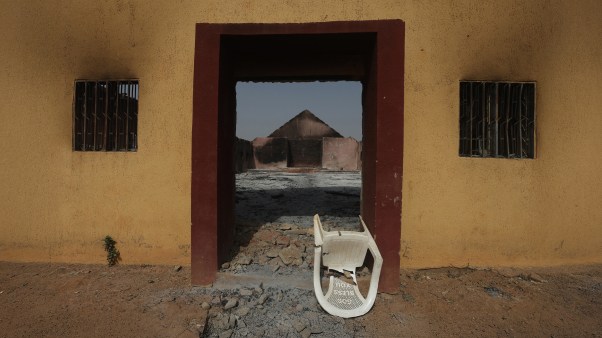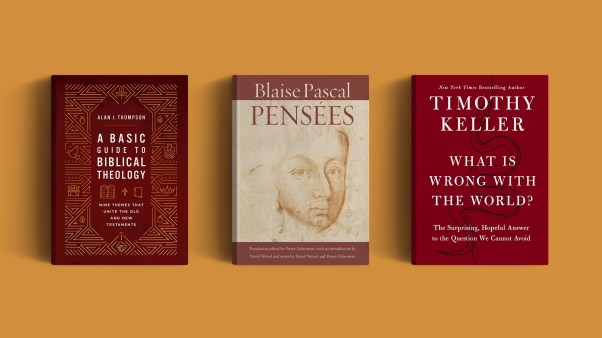Earlier this year, I asked a friend to be a time traveler for a moment, and she and I ended up in the same place.
The time machine wasn’t literal, of course, only imaginative. It was part of my end-of-the-podcast question for my friend and frequent podcast guest Beth Moore. “If you could be dropped down in any biblical scene … except for the Resurrection,” I asked, “where would you go?”
When she answered, “The Transfiguration,” I immediately yelled, “Me too!” because that’s precisely what I had mentally marked as my own answer.
In that moment on the mountain, Peter, James, and John see Jesus overshadowed with a cloud, incandescent with glory, and hear him addressed by God’s voice. The moment ties together much of the rest of the biblical story: the pillar of fire and cloud that guided Israel through the wilderness, the teaching of Jesus (summoning them to a mountain), the crucifixion of Jesus, the Resurrection, the Ascension, the glory of the New Jerusalem to come—it’s all there.
But the part of the transfiguration account that’s been on my mind the most these days is the appearance of Moses and Elijah.
In his book Lifting the Veil: Imagination and the Kingdom of God, Malcolm Guite references his poem “Transfiguration,” which opens with “For that one moment, ‘in and out of time,’ / On that one mountain where all moments meet.” Guite says the wording was inspired by the presence of Moses and Elijah at the Transfiguration, “both of whom in their own time and place had mountain-top experiences of transfigured illumination, both of whom saw God in some ineffable way.” Guite continues,
I wondered if their appearance in the presence of Christ on this mountain top was not a repetition of that first experience or a re-visiting of this World by these Old Testament figures, who represent between them the Law and the Prophets, but rather that the disciples were witnessing the truth that in the light of heaven, in heaven’s time as it were, those three separate moments: Moses’ on his mountain in his time, Elijah in his, and Christ in this Gospel moment were all one moment! If Moses and Elijah saw the face of God in a mystery then it could be none other than the face of Christ.
In other words, what if Moses and Elijah were not at that moment miraculously transcending space (returning from the beyond) but rather transcending time? What if Peter, James, and John were witnessing the exact moment in which Moses was peering into the glory of God on his mountain and when Elijah was on his? What if the glory that Moses reflected when he returned from the mountain—so painfully brilliant that he had to veil his face—was the glory streaming from the face of a transfigured Christ?
In some prior ages, this idea might have seemed ridiculous. But modern science has shown us that the universe is stranger than we ever knew. In the broad sweep of things, we hardly know anything about how time and space work, but we know enough to realize that Augustine was right when he said that time is not a fixed and linear thing but far more complex. Take a physicist to a high school classroom and watch: Among the first questions will be “What was there before the Big Bang?” The physicist will search for some way to say—in terms a human mind can grasp—that “before” doesn’t make sense in that question.
Now, no one knows exactly how Moses and Elijah were present on that mountain. If Beth Moore and I could time travel there, maybe we would ask. But we would, no doubt, hear the same answer that Simon Peter heard when he asked a question in that moment, not knowing what else to say. We would hear, “This is my beloved Son; listen to him” (Mark 9:7, ESV throughout).
Behind all the speculation is a truth that many of us need to hear. After all, we are time travelers too. In one of the last lines he wrote, singer-songwriter Rich Mullins put it this way:
What I really need to know
Is if You who live in eternity
Hear the prayers of those of us
who live in time
We can’t see what’s ahead
And we cannot get free from what
we’ve left behind
In a letter, C. S. Lewis responded to a spiritually struggling Christian who said prayers were meaningless because God has “known for millions of years exactly what you are about to pray,” as Lewis put it. “That isn’t what it’s like. God is hearing you now, just as simply as a mother hears a child.”
The difference His timelessness makes is that this now (which slips away from you even as you say the word now) is for Him infinite. If you must think of His timelessness at all, don’t think of Him having looked forward to this moment for millions of years: think that to Him you are always praying this prayer.
When a child asks how God can hear prayers from Nashville and Nairobi in the same moment, we don’t think of God as quickly shuttling in space between the two. He is omnipresent—just as present in Nashville and Nairobi as on Neptune. Indeed, he transcends the spatial limits of the cosmos itself (1 Kings 8:27). The same is true for time.
When you look back at some past trauma, you can know more than just that God was with you. He is with you back there. Similarly, you can know more than just that God will be with you in the future that you’re worried about now. He is with you there. As the pillar of fire and cloud protectively hemmed in the Israelites of the Exodus from before and behind (Ex. 14:19–20), God is doing the same for you now.You don’t have to understand it. How could creatures bound to the flow and flux of time ever really do so? You can, though, stand in awe at the Jesus of Nazareth who could say, 2,000 years before Einstein, “Before Abraham was, I am” (John 8:58).
Peter wanted to freeze the moment of transfiguration. He wanted to build monuments there, tabernacles that would tie down and make permanent that flash of glory. But he didn’t understand that that’s not how tabernacles work.
The glory of God followed no predictable rhythm when leading the people through the wilderness. They just knew that when they saw the glory descend on the tent, they would camp, and when it didn’t, they would march onward (Ex. 40:34–38). Like Peter, though, we often want to concretize those moments of God’s felt presence—either through nostalgia for some imagined golden age or with anxiety about some imagined future.
Some who are protective of the church calendar might object that I am discussing the Transfiguration when, in this season of Advent and Christmas, we should focus on the Incarnation. But what Elijah and Moses peered into the radiance to see—what Peter, James, and John witnessed—is indeed all about the Incarnation.
The same John who saw the Transfiguration would later write, “And the Word became flesh and dwelt among us, and we have seen his glory, glory as of the only Son from the Father, full of grace and truth” (John 1:14). Behind all the ordinariness of our lives, behind all the sadnesses and disgraces of our time, “the light shines in the darkness, and the darkness has not overcome it” (v. 5).
Perhaps it’s not just coincidence that so many of our Christmas stories of the past play around with the wonkiness of time. Ebenezer Scrooge of A Christmas Carol is shown both the past and the alternate timelines of his future. George Bailey experiences something similar in It’s a Wonderful Life. We sing “O Little Town of Bethlehem” in the present tense, as if we were observing right now the little village at the time of Christ’s birth, noting, “The hopes and fears of all the years are met in thee tonight.”
Perhaps the rhythms of Advent and Christmas drive us all to a kind of time travel. We look around to see who’s not at the table this year. We see those who were once children playing in the wrapping paper as now the grownups we tried to imagine they would become.
We can’t relive the past. We can’t peer into the future. We can’t even hold on to the present. In the eternal “today” of the God who created and fills and transcends time, we can only know this: God is with us.
Russell Moore is editor at-large and columnist at CT.












